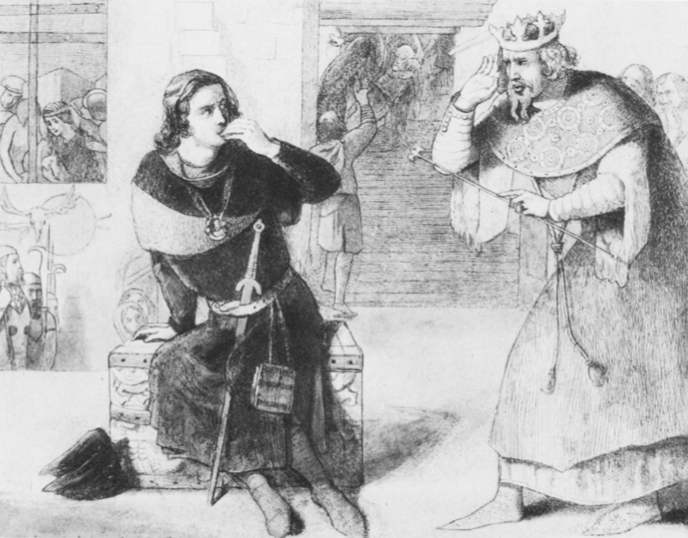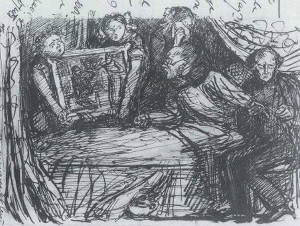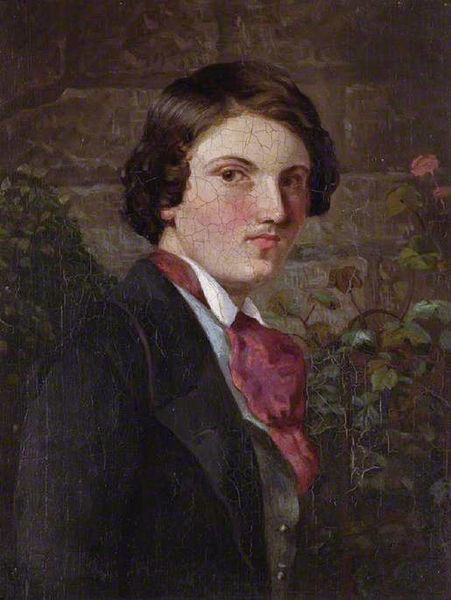Stephanie of preraphaelitesisterhood.com wants your museum pictures! Share them here and enjoy the gallery of starry-eyed loons.
That’s me in the corner. That’s me in the spotlight. Staring down The Bridesmaid.

Stephanie of preraphaelitesisterhood.com wants your museum pictures! Share them here and enjoy the gallery of starry-eyed loons.
That’s me in the corner. That’s me in the spotlight. Staring down The Bridesmaid.
With kind permission from the University of British Columbia, and the help of author of The Rossettis In Wonderland, Dinah Roe, I have a Christmas treat to share with you: Mama Frances Rossetti’s recipe for a frightfully boozy rum punch!
The Rossetti family’s little London parlour was always crammed with displaced Italian revolutionaries, carousing and debating while the cat warmed herself in front of the fire. Christina talks about “chestnuts, cake, and a social glass of grog”, although Dante Gabriel didn’t drink at all until much later in life. (That didn’t stop him, as a child, from feeding beer to a hedgehog and watching it stagger about, the unusual boy). However, I like to think he partook of the occasional sip of family punch. Especially if it was anywhere near as tasty as my attempt!
Let’s give it a go, shall we?
Frances doesn’t give especially detailed instructions, so most of this is guesswork verging on generosity. Here’s the recipe as it appears in Frances’ recipe book:
2 lemons
1 orange
Rum
Brandy
Lump sugar to taste
The lemons being first scraped white, therewith, boiling water.
Looking for further details, I found this fantastic article on Charles Dickens’ favourite punch, circa 1847, involving a pint of rum (!) and a glass of brandy. That, between myself and Mr May, would be lethal, so I’m going to tone down the quantities a bit for the sake of propriety.
Yes, this is classed as research.
I sliced the lemons (first scraping them white with a knife, because for some reason I don’t own cheese grater) and cut the orange into four. I ended up slicing the lemons in half because I didn’t quite believe the juice would get out through the zest. Maybe that was a mistake. We’ll see.
On the hob, I boiled a pint and a half of water, brought it off the boil and added the fruit. I left the lot to simmer for three minutes while I repeatedly got the maths wrong and ended up deciding on half a pint of rum, which, on reflection, was a bit much. Oh, well.
Both the brandy and rum were the finest El Cheapo supermarket bathtub plonk, because, unlike the myriad characteristics of gin, all brands of rum taste to me like aviation fuel. So I added the half pint of rum directly into the pan over a gentle heat, letting it ‘mull’ a bit in the fruit juice, which was beginning to smell pleasantly like Christmas cake.
I then ‘measured’ out roughly a quarter of a pint of brandy. I’m not used to brandy (the stuff I used smelled like a dentist’s surgery) so I took Charles Dickens’ advice (sorry, Uncle Thomas) and spooned it in, setting it alight spoon by spoon. To what benefit, I can’t say, but it made a nice “voomph!” sound and made me feel like some kind of pagan Goddess of winter debauchery.
At this point, mind your hair.
So! Next, I had a little taste test, resulting in flashbacks to childhood toothache remedies. It was quite bitter, and the lemons had crumpled slightly, leaving floating bits of lemon on the surface. I don’t know what Mrs Rossetti would have done, but she seemed the sensible type, so I removed the lemons and let the oranges take over.
I added a liberal quantity of brown sugar, and stirred the punch for a few minutes. The rum really needs a bit of sweetness to balance it out, but it’s all personal taste.
Once the lemons were out, the punch began to taste much more recognisably fruity (I suspect winter lemons in this country are just a bit mean-tasting) and the sugar and alcohol complemented each other nicely.
* Don’t let it boil
* Take a distinctly un-Victorian swizzle stick and give it a good stir.
* Pour into a tall glass because I don’t own any other kind of glass.* As Christina wisely suggested, add cake.
It actually tastes delicious. It is distinctly piratey – grog! – though the citron gives it a more festive kick than something you’d swig before pillaging a small coastal town.
Queer loaves are the best loaves.
Frances did her best to reproduce Italian food for her family. Indeed, Dante Gabriel was still sourcing cannelloni from Soho decades later. However, I always think of him when I buy my Christmas panettone. In 1874, he wrote to Frances:
I have been painting from a little Italian boy who highly appreciates Toscone; but on my giving him a piece of Panattone (that queer loaf) he said in a startled tone, “Quanto costa questo?”* I replied “Non credo molto,” & he rejoined “Crederei quasi neinte”. Such was his verdict on that comestible.
To complete the experience, I’m going to curl up on the sofa with my copy of The Collected Letters of Jane Morris, an incredibly thoughtful gift from Becki of Fifteen Precise Facts.
Buon Natale, everyone!
*“How much is this?”
“I do not think much.”
“I would think almost nothing.”

Since I blogged about Walter Howell Deverell’s Twelfth Night, I’ve been wanting to spend a bit more time with the poor doomed boy. So here’s a treat – the study for his ill-fated The Banishment of Hamlet. Dante Gabriel Rossetti was most likely the model for Hamlet.
Walter is mostly remembered as the ‘lost’ Pre-Raphaelite who discovered Lizzie Siddal in a hat shop. Had he accepted full membership into the Brotherhood, he may have been better regarded today, but Walter was the eldest of seven surviving siblings, motherless and later fatherless, too. Linking his name to a controversial gang of artistic upstarts seemed like another way to make life difficult for him and his dependants. As such, he tends to be relegated to a walk-on character in the story of Rossetti’s love-life.
 By all accounts, Walter was a nice young thing, and highly sought-after as a model among the PRB. He was especially close to Rossetti, cackling over clueless patrons in the rooms they rented together in Red Lion Square – purportedly so dingy that Walter’s doctor was moved to pat Rossetti on the head and mutter “poor boys, poor boys”.
By all accounts, Walter was a nice young thing, and highly sought-after as a model among the PRB. He was especially close to Rossetti, cackling over clueless patrons in the rooms they rented together in Red Lion Square – purportedly so dingy that Walter’s doctor was moved to pat Rossetti on the head and mutter “poor boys, poor boys”.
Looking like a Victorian Johnny Depp, Walter had a mildly-exaggerated reputation for driving girls to distraction, although his infamous comment about PRB standing for “penis rather better” was probably in reference to the constant pain he would have suffered with the Bright’s Disease that eventually killed him, aged 26. Having had acute pyelonephritis aged 14, I can attest to its utter mind-bending awfulness, which is one of the reasons I feel so sympathetic towards poor old Walter.
The Banishment of Hamlet was doomed from the beginning, receiving a typically venomous Athenaeum review:
Hamlet himself, in spite of his being perched upon a square box in the gawky, shrinking attitude of a delinquent school-boy, might, with an effort, be allowed to pass as not wholly un-Shakespearian; but his yellow, pink, and blue majesty Claudius, who pokes towards his nephew in a withering attitude – copied, perchance, from the Bayeux Tapestry – is.
The painting was roundly abused when it appeared at the National Institution in 1851, went unsold, and then, depending on the source, was either blown up in a gas accident or lost in a fire. The study above resides in the Ashmolean under another name, making it difficult to trace.
William Michael Rossetti penned a kinder review*, praising the prince’s moodiness in the same terms he reserved for descriptions of his brother around the same time:
There is a certain brooding indolence in his whole figure; irresolution is shown in the movement of his hand, and mingles even with the settled scorn of his eyes.
The ‘delinquent school-boy’ attitude of Walter’s Hamlet may well have been inspired by his friend’s air of insouciance; his habit of pulling his sleeves down over his hands and flicking his long fingernails when nervous. The painting certainly seems to have been the subject of jokes between the pair as seen in these cartoons by Rossetti in which the lads’ Irish patron MacCracken erupts with delight at the sight of something that looks an awful lot like Walter’s Hamlet:

‘The long expected Deverell, arriving at length/ find M’C laid up with the sickness of/hope deferred. Owing to an unfortunate error/of packing, the patient is strongly excited on seeing it/and there seems every reason to fear the worst.’ – DGR’s caption
There are lots of these over on The Rossetti Archive, suggesting that Hamlet’s unsaleability was a source of humour rather than anguish. Indeed, Walter exhibited a strange, fatalistic disinterest in the way no one seemed to want his pictures.
I love the way Rossetti always depicts himself as scruffy and round-shouldered next to Deverell’s rather natty figure. Perhaps the ‘delinquent school-boy’ comment appealed to his sense of humour, or perhaps it was a gentle dig at Walter’s popularity with the girls.
It’s a shame that Walter has become a footnote in Rossetti and Siddal’s relationship. There’s a sweetness to his surviving paintings that I find refreshing. Pretty girls pose with pretty birds, and Shakespearean characters totter about in pointy shoes and bright tunics like tableaus from a child’s picturebook. It would be easy to write them off as twee, and perhaps that’s precisely what happened, but I think Walter may have sought out idyllic scenes on purpose, what with the stress of his family responsibilities, the purgatives prescribed for Bright’s Disease, and the eventual realisation that he wasn’t going to make it. His poetry, published in The Germ, betrays a troubled frame of mind:
Though we may brood with keenest subtlety,
Sending our reason forth, like Noah’s dove,
To know why we are here to die, hate, love,
With Hope to lead and help our eyes to see
Through labour daily in dim mystery,
Like those who in dense theatre and hall,
When fire breaks out or weight-strained rafters fall,
Towards some egress struggle doubtfully;
Though we through silent midnight may address
The mind to many a speculative page,
Yearning to solve our wrongs and wretchedness,
Yet duty and wise passiveness are won, —
(So it hath been and is from age to age) —
Though we be blind, by doubting not the sun.
Walter died on the 2nd of February 1854. He only sold one painting in his lifetime.
Rossetti wrote to Ford Madox Brown: “He had been told in the morning that he could not live through the day and he appeared to receive the announcement without emotion or surprise, saying he supposed he was man enough to die”.
It was the first big loss of Rossetti’s life. “I have none left who I love better, and I doubt whether any who loves me so well,” he wrote to Walter’s family. By 1870, he was still trying to sell The Banishment of Hamlet to raise funds for Walter’s surviving family. If he had succeeded, perhaps we would still have it today.

*It has been argued this was DGR writing under WMR’s name, but I’m going to trust the original citation for the time being.